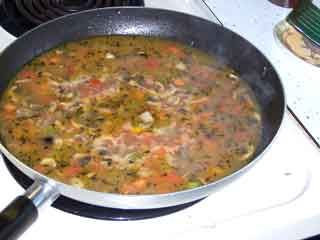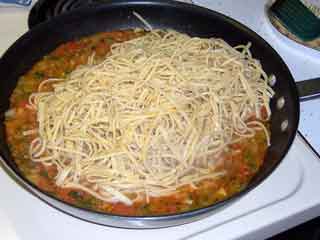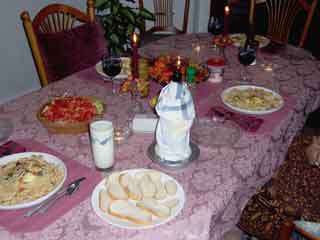The secret, of course, is: the sauce.
Sure. Poach the shrimp. Make a sauce. Toss pasta with sauce, add shrimp to top and serve. Simple, right? Not in my kitchen! . . .
Here’s what you’ll need . . .
1 lb. Poached shrimp
2, 4, 6, 23 . . . garlic cloves
½ to 1 onion
½ green bell pepper
½ red bell pepper
¼ italian pepper (they look like pepperoncini on steroids)
2 – 4 mushrooms
1 – 2 tomatoes
8 – 12 black olives
zucchini (at least ½ of one, more if you like)
summer squash (as above with the zuke)
juice from ½ lemon
juice from ½ limes
½ tsp. sriracha (SE Asian chile sauce)
1 – 3 tsp. fish sauce (Tiparos)
sesame oil
olive oil
White wine
½ tsp. ground cumin
freshly ground Tellicherry (black pepper)
‘italian seasonings’
cilantro
linguine, fettuccini, vermicelli, and/or angel hair
Gather all the ingredients before you start. Poach the shrimp as described in the Poached Shrimp(s) post from last week.

While your shrimp shells are cooking, chop up the veggies for the sauce (garlic, onions, tomatoes, peppers, and black olives).
When it comes time to poach the shrimp, stop whatever else you’re doing. Pay attention to the shrimp!
Ok. Set them aside and get some water going to boil your pasta.

While your water is heating up, chop up the rest of the veggies. I like to use pretty big chunks so they sit in the sauce instead of becoming part of it. The mushrooms can go either way. Some times I’ll whack them up into little bits and let them be sauce; sometimes, big chunks and they’re vegetables; and sometimes I can’t decide so they just get sliced!

Cook your pasta. Leave it a little more al dente than you usually like it. It’s going to cook some more in the sauce – not much, but some, and you want the pasta in this dish to have some character, not to be all mushy.
So, while your pasta is cooking, mix up a marinade for your shrimp. I go back and forth about how much flavor to put on the shrimp while they sit and how much to put into the sauce as it cooks. At a minimum, give your shrimp a light coat of sesame oil and let ‘em sit in the lemon and lime juice. Next time you do this meal, try adding another ingredient (or 12) and see what happens.
By now, your pasta is certainly cooked. Before you dump it into the colander, though, pour off a couple of cups of the pasta water into a bowl or measuring cup. Like the shrimp broth, you’ll be adding (at least some of) this liquid to the sauce. Then, drain the pasta thoroughly, dump it back in the pot, give it a goodly squirt of sesame oil, and dig your hands in there! The idea is to coat every strand with oil.

On to the sauce! Crank up the skillet, pour in some olive oil (at least a couple of tablespoons – it’s an ingredient as well as the cooking oil), swirl once or twice until, as they say, the oil comes to fragrance. Turns out, ‘they’re’ right. It actually does give off a beautiful fresh fragrance when it gets to just the right temperature.
And that’s just the moment to toss in the onions. Swirl them around, turn the heat back down to something civilized (about where you’d put the stove for a hearty simmer), and sauté the onions for about 2 minutes. (Sautee is a French verb, to jump. Don’t take it literally here. If your onion is jumping out of the pan, the stove is too hot!)
Add in some of the peppers, and give them about two minutes also. Now the garlic and the rest of the peppers. About a minute and toss in the mushrooms. Another minute or three and finally, the tomatoes and black olives. As soon as the temperature comes back up, but before any jumping starts, pour in a goodly slug of white wine. There are flavors in those tomatoes that will only come out in the presence of alcohol. So give ‘em a little (if you can – if you can’t, Don’t! Your dish will still taste great!)
So Ok. After about 5 more minutes, the mushrooms will have given up their juices, the tomatoes will be breaking down, the garlic will be filling your nostrils, it’s time to add some liquid. Start with every last drop of your shrimp broth. Then add pasta water to bring the liquid level to within about ½ inch of the top of the skillet. And stir it all around.
If you don’t have enough pasta water to get it that high, just add some plain water and or some more white wine. The measurements here are not critical. You just want a goodly bucketful so you can cook it down to about half that much. Should take about 10 minutes to reduce the volume by half.

And during that time, add in whatever you haven’t added to the shrimp marinade. Start with the sriracha. That way, the heat will get gently distributed throughout the sauce as it reduces.
Then add the herbs and spices. Use whatever proportions you like, but some oregano and basil for sure, maybe some savory if you’ve got it, or even a tiny amount of rosemary and/or thyme if you don’t have any savory. As always, if you’ve got fresh herbs, use them; if not, the dried versions will be fine. And remember to crush dried herbs in the palm of your hand before tossing them in – it really does release a lot more flavor.
As you near the ‘right’ amount of sauce (about half the height of the pan), add the fish sauce (it’s salty and you don’t want to concentrate the salt – you want to season with it).
Finally, pour in the pasta and turn, stir, roll, separate, and otherwise mix it all about. As you did with the oil, try to get every strand individually coated with your incredible sauce. By the time you get this accomplished, at least 5 minutes will have passed, and it’s time to add the shrimp and every last drop of whatever marinade you’ve had them sitting in!

Stir them in gently, turning things over and under for about another 2 or 3 minutes. By then, the marinade flavors will have blended, the shrimp will have warmed, the sauce will have perfected, and it’s time to serve. Sprinkle some (more?) cilantro over the top of each plate, and . . .

Eat!!

phew . . .
No comments:
Post a Comment